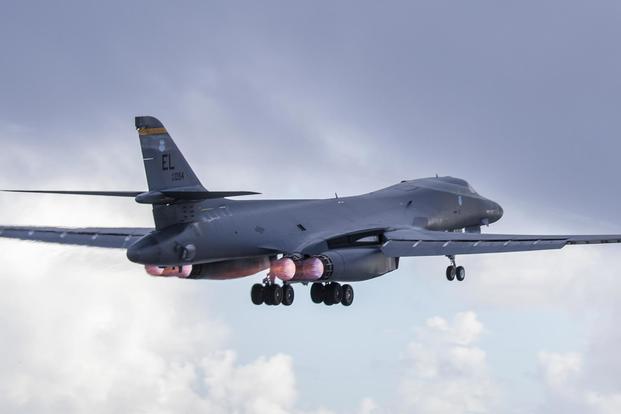The B-1B Lancer is back in the Middle East for the first time in nearly two-and-a-half years to take over strike missions from B-52 Stratofortress bombers.
The non-nuclear bombers from Ellsworth Air Force Base, South Dakota, arrived at Al Udeid Air Base, Qatar, on March 31, according to social media posts from Air Forces Central Command.
The Lancers will be primarily focused on Operation Inherent Resolve, the fight against ISIS in Iraq and Syria, and Operation Freedom Sentinel in Afghanistan, AfCent said. The command would not give details on how many bombers are involved or on the duration of the mission.
"Following two years supporting U.S. Pacific Command requirements, the B-1 returns to the U.S. Central Command [area of responsibility] where it will take over bomber duty from the venerable B-52 Stratofortress," AfCent posted on Twitter.
Related content:
- B-1B Lancer's Evolving Mission Includes More Close-Air Support
- Arms Control Experts: US Not Planning Nuke Strike Against North Korea
- B-1 Bomber Crews Defend Sniper Pod After Friendly Fire Incident
"The [B-52] will soon depart following two years in which it played an instrumental role in the fights against ISIS and the Taliban, clocking more than 1,800 sorties and approximately 12,000 weapons released against targets in Iraq, Syria and Afghanistan," the message continued.
The long-range B-52 bombers, known as "Big Ugly Fat Fellow," or BUFF, transitioned back to the Pacific earlier this year, replacing the B-1Bs for an 18-month-long mission.
The B-1 took over that mission in 2016, marking the first time since 2006 that Lancers had been housed at Andersen Air Force Base, Guam.
In December, B-1 pilots and crew members told Military.com they were training round-the-clock for the evolving battlespace in the Middle East.
Military.com sat down with leaders from Air Force Global Strike Command's 7th Bomb Wing, responsible for producing combat-ready aircrews in the Air Force's only formal B-1B training unit, during a trip to Dyess Air Force Base, Texas, in December. The trip also included a ride in the B-1B over training ranges in New Mexico.
The aircraft, known as the "Bone," left the U.S. Central Command area of responsibility in early 2016 and was replaced by B-52 Stratofortress bombers at Al Udeid that April.
Air Force officials at the time said the B-1B's return stateside was crucial to upgrade the fleet with the latest Integrated Battle Station, or IBS. The IBS upgrade has been incorporated into more than half of the 62 total aircraft.
Before its 2016 departure, the aircraft deployed the most weapons of any aircraft involved in the anti-ISIS campaign, according to statistics provided to Air Force Times. The B-1B was responsible for almost 40 percent of Air Force bombs on Islamic State targets, according to service statistics.
Now, even as the air campaign against ISIS steadily winds down, it still requires "surgical strikes," or precision-guided bombs on target as the battlespace continues to shrink, Maj. Charles "Astro" Kilchrist, chief of training for the 9th Bomb Squadron, said in December.
Meanwhile, the U.S. has increased airstrikes in Afghanistan in support of Operation Freedom’s Sentinel.
The Air Force has been shifting more MQ-9 Reaper drones for overwatch and strike missions; additional combat search-and-rescue squadrons; and A-10C Thunderbolt II ground attack aircraft, which recently arrived at Kandahar Airfield, for close-air support strikes.
In January, the aircraft joined F-16 Fighting Falcon fighter jets, C-130J Hercules mobility airlift, EC-130H Compass Call electronic attack aircraft, and other planes already in the AOR supporting these operations from Bagram Airfield.
-- Oriana Pawlyk can be reached at oriana.pawlyk@military.com. Follow her on Twitter at @Oriana0214.














